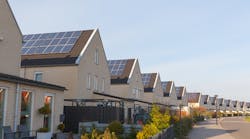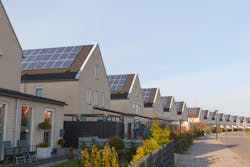Many homeowners don’t think solar power is for them. The technology isn’t ready, or their location isn’t right, or maybe they plan on moving soon. The folks at Solar Authority, a website that helps users choose solar array systems, look into these myths and handily debunk them.
Myth 1: Solar panels do not work well in cold climates.
Fact: Most solar panels actually work best in cold conditions, as long as it’s sunny. Cold temperatures increase their conductivity, letting electricity flow more efficiently. Higher temperatures, on the other hand, reduce the panels’ efficiency. As solar panels heat up, they generate less electricity from the same amount of light.
Myth 2: Solar power should get more efficient as technology improves, so I should wait before I invest in it, right?
Fact: Many companies strive to improve solar-panel efficiency. But we’ve generally been using the same solar technology since the 1960s. The potential efficiency gains of future panels are almost always small, a few percentage points, compared to the panels available ready for installation. Waiting for any large improvement is a risk while expected efficiency gains when measured in dollars saved on energy bills is miniscule. So there’s little reason to wait.
Myth 3: I won’t live in my home long enough to earn an ROI on any money I put into solar panels.
Fact: Depending on your system and location, solar panels pay for themselves within six to 15 years. If you add in the most lucrative state and federal tax credits and incentives, you could start seeing an ROI within two to four years. Solar panels also increase the resale value of a home by about $15,000. So even if you won’t be in your home for the next 15 years, you can still see a significant ROI when you sell.
Myth 4: Solar panels require a tracking system to follow the angle of the sun.
Fact: If solar panels are properly installed, they are positioned to get the most exposure to the sun, so tracking systems are not required. Some newer panels do use tracking subsystems to adjust the panel’s position throughout the day, but the additional expense may not be worth the limited efficiency gains.
Myth 5: Solar panels don’t operate well in snowy or cloudy conditions.
Fact: Snowy and cloudy weather can reduce the amount of energy a solar panel generates, but they can still work efficiently in these conditions. In snowy climates, most panels are installed at an angle so snow slides off once it accumulates, and rain can clear debris from panels, helping them to be more efficient. In fact, Germany, a country which receives half as much sun as the sunniest city in the U.S., has one of the most successful solar initiatives in the world.
Myth 6: Solar panels are unattractive.
Fact: Professional installers can place solar panels on any roof pitch, angle, and condition. They will not damage a homeowner’s roof, and, in some cases, solar panels extend the roof’s life by protecting it from the elements. Ultimately, the aesthetics of solar panels on a home are subjective. However, with the growing popularity of solar power, professionals can install solar panels in positions and locations to minimize their visual impact. Depending on your yard, panels can even be mounted on the ground. Solar shingles can also help with curb appeal by better blending in with your existing roof.
Myth 7: Solar panels require constant maintenance.
Fact: Solar arrays are designed to be durable and require minimal maintenance. Many installers recommend annual inspections to check the panels and system performance, and some offer lifetime warranties for the system. Plus, if you lease the panels and system, maintenance is typically provided by the leasing company. Keep in mind, panels with tracking subsystems may require additional maintenance and care.
Myth 8: Only a few states offer financial incentives for installing solar panels.
Fact: Almost every state in the U.S. has some type of tax incentive for solar power. Research the solar energy incentives and policies in your state. In addition to any state incentives, the federal government currently offers a 30% tax credit for solar array systems installed before 2020.
Myth 9: Solar panel systems store excess energy in batteries.
Fact: The vast majority of home solar power systems don’t store energy in batteries. They’re connected to the power grid via net metering, and homeowners are credited with the energy their solar panels add to the electrical grid. Though it is possible to add a battery to your solar installation, doing so increases the cost of materials, installation, and maintenance.


